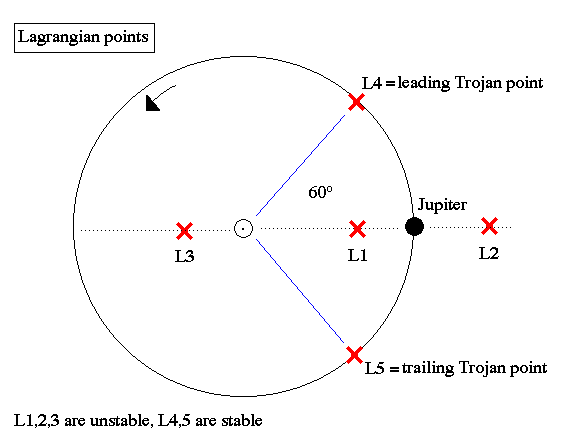
In 1772 the French mathematician and astronomer Joseph-Louis Lagrange predicted the existence and location of two groups of asteroids located near the (L4 and L5) equilateral triangular stability points of a three-body system formed by the Sun, Jupiter, and the asteroids. These are two of the five stable points in the circular, restricted three-body problem. The other three stable points are located along a line passing through the Sun and Jupiter. Because of the presence of other planets, principally Saturn, the Sun-Jupiter-Trojan asteroid system is not a true three-body system, and so these other three points are not stable and no asteroids have been found near them. In fact, most of Jupiter's Trojan asteroids do not move in the plane of its orbit but rather in orbits inclined by up to 40 and at longitudes that differ by as much as 70 from the longitudes of the true Lagrangian points.

In 1906 Max Wolf discovered 588 Achilles near the Lagrangian point preceding Jupiter in its orbit. Within a year August Kopff had discovered two more: 617 Patroclus, located near the following Lagrangian point, and 624 Hector near the preceding Lagrangian point. It was later decided to name such asteroids after the participants in the Trojan War as given in the Iliad and, furthermore, to name those near the preceding point after Greek warriors and those near the following point after Trojan warriors. With the exception of the two previously named "spies" (Hector, the lone Trojan in the Greek camp, and Patroclus, the lone Greek in the Trojan camp), this tradition has been maintained. Of the named Trojans, Achilles, Hector, Nestor, Agamemnon, Odysseus, Ajax, Antilochus, Diomedes, and Menelaus are near the Lagrangian point 60 ahead of Jupiter. Patroclus, Priamus, Aeneas, Anchises, and Troilus are about 60 behind Jupiter.
The term Trojan has since been applied to any object occupying the equilateral Lagrangian points of other pairs of bodies. Searches have been made for Trojans of the Earth, Saturn, and Neptune, as well as of the Earth-Moon system, but so far none have been found. It was long considered doubtful whether truly stable orbits could exist near these Lagrangian points because of perturbations by the major planets. However, in 1990 an asteroid librating about the following Lagrangian point of Mars was discovered by the American astronomers David H. Levy and Henry E. Holt, thus reopening this question.
Although only about 65 Trojans have been numbered, photographic surveys have shown that there are about 2,300 +/- 500 such asteroids with diameters greater than 15 kilometres. About 1,300 of these are located near the preceding Lagrangian point and 1,000 near the following Lagrangian point.
The known Trojans undoubtedly rank among the larger asteroids but appear faint because of their great distance from the Earth. There are probably many smaller and even fainter members as yet undiscovered.
Excerpt from the Encyclopedia Britannica without permission.